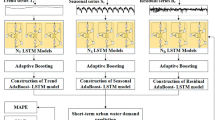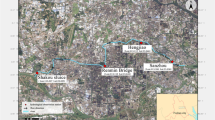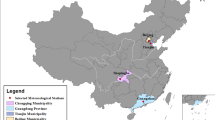Abstract
Short-term water demand forecasting provides guidance on real-time water allocation in the water supply network, which help water utilities reduce energy cost and avoid potential accidents. Although a variety of methods have been proposed to improve forecast accuracy, it is still difficult for statistical models to learn the periodic patterns due to the chaotic nature of the water demand data with high temporal resolution. To overcome this issue from the perspective of improving data predictability, we proposed a hybrid Wavelet-CNN-LSTM model, that combines time-frequency decomposition characteristics of Wavelet Multi-Resolution Analysis (MRA) and implement it into an advanced deep learning model, CNN-LSTM. Four models — ANN, Conv1D, LSTM, GRUN — are used to compare with Wavelet-CNN-LSTM, and the results show that Wavelet-CNN-LSTM outperforms the other models both in single-step and multi-steps prediction. Besides, further mechanistic analysis revealed that MRA produce significant effect on improving model accuracy.

Similar content being viewed by others
References
Adamowski J F (2008). Peak daily water demand forecast modeling using artificial neural networks. Journal of Water Resources Planning and Management, 134(2): 119–128
Amari S I, Wu S (1999). Improving support vector machine classifiers by modifying kernel functions. Neural networks: the official journal of the International Neural Network Society or Neural Netw, 12(6): 783–789
Bedi J, Toshniwal D (2019). Deep learning framework to forecast electricity demand. Applied Energy, 238: 1312–1326
Billings R B, Jones C V (2011). Forecasting Urban Water Demand. Washington, DC: America Water Works Association
Boggess A, Narcowich F J (2015). A first course in wavelets with Fourier analysis. 2nd ed. John Wiley & Sons, 183–217
Bougadis J, Adamowski K, Diduch R (2005). Short-term municipal water demand forecasting. Hydrological Processes, 19(1): 137–148
Bouvrie J (2006). Notes on convolutional neural networks.
Bracewell R N (1989). The Fourier transform. Scientific American, 260(6): 86–95
Candelieri A, Giordani I, Archetti F, Barkalov K, Meyerov I, Polovinkin A, Sysoyev A, Zolotykh N (2019). Tuning hyperparameters of a SVM-based water demand forecasting system through parallel global optimization. Computers & Operations Research, 106: 202–209
Cao J, Wang J (2019). Stock price forecasting model based on modified convolution neural network and financial time series analysis. International Journal of Communication Systems, 32(12): e3987
Chen G, Long T, Xiong J, Bai Y (2017). Multiple random forests modelling for urban water consumption forecasting. Water Resources Management, 31(15): 4715–4729
Chen J, Boccelli D (2014). Demand forecasting for water distribution systems. Procedía Engineering, 70: 339–342
Cheng J, Liu Y, Ma Y (2020). Protein secondary structure prediction based on integration of CNN and LSTM model. Journal of Visual Communication and Image Representation, 71: 102844
Dara S, Tumma P (2018). Feature extraction by using deep learning: a survey. In: Second International Conference on Electronics 2018, Communication and Aerospace Technology (ICECA), IEEE, Coimbatore, RVS Technical Campus, Coimbatore, India, 1795–1801
Duerr I, Merrill H R, Wang C, Bai R, Boyer M, Dukes M D, Bliznyuk N (2018). Forecasting urban household water demand with statistical and machine learning methods using large space-time data: a comparative study. Environmental Modelling & Software, 102: 29–38
Firat M, Turan M E, Yurdusev M A (2010). Comparative analysis of neural network techniques for predicting water consumption time series. Journal of Hydrology (Amsterdam), 384(1–2): 46–51
Ghiassi M, Zimbra D K, Saidane H (2008). Urban water demand forecasting with a dynamic artificial neural network model. Journal of Water Resources Planning and Management, 134(2): 138–146
Goodchild C (2003). Modelling the impact of climate change on domestic water demand. Water and Environment Journal: the Journal/the Chartered Institution of Water and Environmental Management, 17(1): 8–12
Guo G, Liu S, Wu Y, Li J, Zhou R, Zhu X (2018). Short-term water demand forecast based on deep learning method. Journal of Water Resources Planning and Management, 144(12): 04018076
Hafeez G, Alimgeer K S, Khan I (2020). Electric load forecasting based on deep learning and optimized by heuristic algorithm in smart grid. Applied Energy, 269: 114915
Herrera M, Torgo L, Izquierdo J, P’erez-Garc’ıa R (2010). Predictive models for forecasting hourly urban water demand. Journal of Hydrology (Amsterdam), 387(1–2): 141–150
Hochreiter S (1998). The vanishing gradient problem during learning recurrent neural nets and problem solutions. International Journal of Uncertainty, Fuzziness and Knowledge-based Systems, 6(2): 107–116
Hochreiter S, Schmidhuber J (1997). Long short-term memory. Neural Computation, 9(8): 1735–1780
Hu P, Tong J, Wang J, Yang Y, de Oliveira Turci L (2019). A hybrid model on CNN and bi-LSTM for urban water demand prediction. In: 2019 IEEE Congress on evolutionary computation (CEC), Wellington, New Zealand, 1088–1094
Huang C W, Chiang C T, Li Q (2017). A study of deep learning networks on mobile traffic forecasting. In: IEEE 28th annual international 2017 symposium on personal, indoor, and mobile radio communications (PIMRC), Montreal, Quebec, Canada, 1–6
Jowitt P W, Xu C (1992). Demand forecasting for water distribution systems. Civil Engineering Systems, 9(2): 105–121
Kurata G, Ramabhadran B, Saon G, Sethy A (2017). Language modeling with highway lstm. In: IEEE Automatic Speech Recognition and Understanding Workshop (ASRU) 2017, Okinawa Japan, 244–251
Maidment D R, Parzen E (1984). Time patterns of water use in six texas cities. Journal of Water Resources Planning and Management, 110(1): 90–106
Mu L, Zheng F, Tao R, Zhang Q, Kapelan Z (2020). Hourly and daily urban water demand predictions using a long short-term memory-based model. Journal of Water Resources Planning and Management, 146(9): 05020017
Nussbaumer H J 1981 The Fast fourier transform. In: Fast Fourier Transform and Convolution Algorithms, 80–111
Oliveira G H, Cavalcante R C, Cabral G G, Minku L L, Oliveira A L (2017). series forecasting in the presence of concept drift: A pso-based approach. In: IEEE 29th International Conference on Tools with Acritical Intelligence (ICTAI), Boston, USA, 239–246
Pincus S (1995). Approximate entropy (apen) as a complexity measure—Chaos: an interdisciplinary Journal of Nonlinear Science, 5(1): 110–117
Peña-Guzmán C, Melgarejo J, Prats D (2016). Forecasting water demand in residential, commercial, and industrial zones in Bogotá, Colombia, using least-squares support vector machines. Mathematical Problems in Engineering, 2016
Sainath T N, Vinyals O, Senior A, Sak H (2015). Convolutional, long short-term memory fully connected deep neural networks. In: 2015 IEEE international conference on acoustics, speech and signal processing (ICASSP). IEEE, Brisbane, Queensland, Australia, 4580–4584
Sharma S, Sharma S, Athaiya A (2017). Activation functions in neural net-works. Towards Data Science, 6(12): 310–316
Sherstinsky A (2020). Fundamentals of recurrent neural network (RNN) and long short-term memory (LSTM) network. Physica D. Nonlinear Phenomena, 404: 132306
Simonyan K, Zisserman A (2014). Very deep convolutional networks for large-scale image recognition. arXiv preprint arXiv:14091556
Sønderby S K, Winther O (2014). Protein secondary structure prediction with long short-term memory networks. arXiv preprint arXiv:14127828
Song X, Liu Y, Xue L, Wang J, Zhang J, Wang J, Jiang L, Cheng Z (2020). Time-series well performance prediction based on long short-term memory (LSTM) neural network model. Journal of Petroleum Science Engineering, 186: 106682
Sundermeyer M, Ney H, Schlüter R (2015). From feedforward to recurrent LSTM neural networks for language modeling. IEEE/ACM Transactions on Audio, Speech, and Language Processing, 23(3): 517–529
Torres J F, Fernández A M, Troncoso A, Martínez-Álvarez F (2017). Deep learning-based approach for time series forecasting with application to electricity load. In: International Work-Conference on the Interplay between Natural and Artificial Computation. Berlin: Springer. 203–212
Ullah A, Ahmad J, Muhammad K, Sajjad M, Baik S W (2018). Action recognition in video sequences using deep bi-directional LSTM with CNN features. IEEE Access: Practical Innovations, Open Solutions, 6: 1155–1166
Xenochristou M, Kapelan Z, Hutton C, Hofman J (2017). Identifying relationships between weather variables and domestic water consumption using smart metering. Proceedings of the CCWI
Yang J, Li J (2017). Application of deep convolution neural network. In: 14th International Computer Conference on Wavelet Active Media and Technology Information Processing 2017 (ICCWAMTIP), University of Electronic Science And Technology of China, China, 229–232
Yu B, Yin H, Zhu Z (2017a). Spatio-temporal graph convolutional networks: a deep learning framework for traffic forecasting. arXiv preprint arXiv:170904875
Yu R, Li Y, Shahabi C, Demiryurek U, Liu Y (2017b). Deep learning: A generic approach for extreme condition traffic forecasting. In: Proceedings of the 2017 SIAM international Conference on Data Mining, Houston, Texas, USA, 777–785
Zen H (2015). Acoustic modeling in statistical parametric speech synthesis-from HMM to LSTM-RNN: Conference: RTTH Summer School on Speech Technology, A Deep Learning Perspective, Barcelona, Spain
Zhang G P (2001). An investigation of neural networks for linear time-series forecasting. Computers & Operations Research, 28(12): 1183–1202
Zhou S L, McMahon T A, Walton A, Lewis J (2000). Forecasting daily urban water demand: a case study of Melbourne. Journal of Hydrology (Amsterdam), 236(3–4): 153–164
Acknowledgements
This work was financially supported by the National Natural Science Foundation of China (No. 51978494), and the Science and Technology Innovation Program Project of Shanghai City Investment Co., Ltd. (No. CTKY-ZDXM-2020-012).
Author information
Authors and Affiliations
Corresponding author
Additional information
Highlights
• A novel deep learning framework for short-term water demand forecasting.
• Model prediction accuracy outperforms other traditional deep learning models.
• Wavelet multi-resolution analysis automatically extracts key water demand features.
• An analysis is performed to explain the improved mechanism of the proposed method.
Data Accessibility Statement
The data supporting the findings of this study are available within the article and its supplementary materials. The code not available due to intellectual property rights of cooperative institute restrictions.
Supporting Information
Rights and permissions
About this article
Cite this article
Pu, Z., Yan, J., Chen, L. et al. A hybrid Wavelet-CNN-LSTM deep learning model for short-term urban water demand forecasting. Front. Environ. Sci. Eng. 17, 22 (2023). https://doi.org/10.1007/s11783-023-1622-3
Received:
Revised:
Accepted:
Published:
DOI: https://doi.org/10.1007/s11783-023-1622-3




